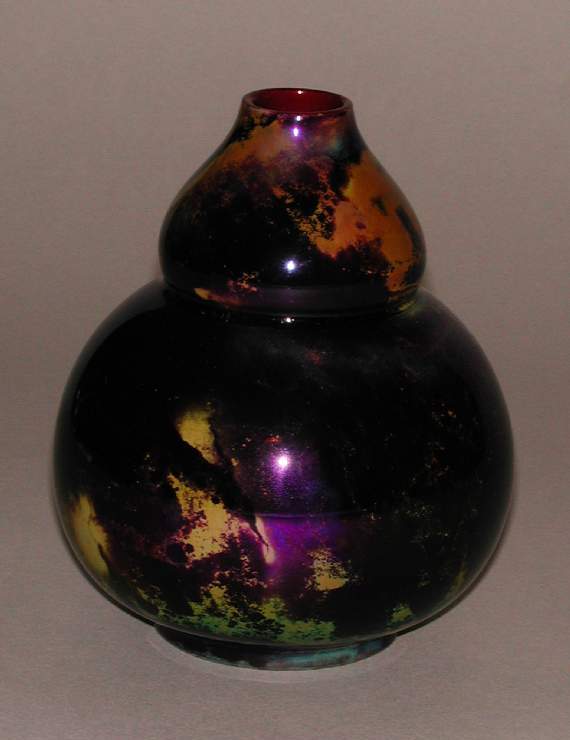Current Location: In storage
Titles
Lustreware vase
Maker(s)
Potter:
Moore, Bernard
Entities
Categories
Description
Earthenware vase, with purple lustre and deep red glazes. A double gourd shape with a narrow round opening at the top, standing on a small foot-ring. The exterior is completely covered with a purple, blue and gold-coloured lustrous glaze, which deepens and lightens over the surface. The interior and underside are covered with a deep red glaze.
Notes
History note: Bought from Bernard Moore at Wolfe Street, Stoke-on-Trent, on 24 March 1920, by Dr Glaisher, Trinity College, Cambridge. Price three guineas (£3 and 3 shillings).
Legal notes
Dr J.W.L.Glaisher Bequest, 1928
Measurements and weight
Diameter: 10 cm
Diameter: 4 in
Height: 12.3 cm
Height: 4.875 in
Acquisition and important dates
Method of acquisition: Bequeathed
(1928)
by
Glaisher, J. W. L., Dr
Dating
20th Century, Early
Circa
1910
CE
-
1920
CE
Note
Bernard Moore (1850-1935), with his brother Samuel (c.1852-1890), took over the family pottery at Longton in 1867. Moore Bros. made good, marketable china for domestic use and produced innovative cloisonné enamels and turquoise and ruby glazes inspired by Persian, Japanese and Chinese wares. Bernard Moore travelled widely, exhibiting and winning medals for the firm in Australia and the United States. In 1905 he sold the business and took a few employees with him to Wolfe Street, Stoke-on-Trent, where he concentrated on lustres and experimental glazes, notably copper-red ‘rouge flambé’ (or ‘sang de boeuf’) and crystalline glazes. Blanks were supplied by the larger factories in the area, to Moore’s design, and artists employed as decorators were given scope for their own designs. Moore’s main income, however, came as consultant to many firms (including Wedgwood and Doulton), advising on body composition, glazing recipes and firing temperatures, and this role continued into the 1930s. In later years Moore also became a writer on pottery science and a passionate public advocate on trade and health issues, including the elimination of silicosis and the ban on lead glazes.
The double gourd shape was often used by Moore, although the glaze on this example seems unusual. It is a late example, as Wolfe Street production diminished after 1915. The body appears to be earthenware, but Moore worked with a wide variety of bodies, including also porcelaneous stoneware, porcelain and bone china. Moore’s deep glaze colours arise from a metal base reduction fired in a gas-fired muffle kiln.
School or Style
Art Pottery
Components of the work
Decoration
composed of
lustre
glaze
Neck
Diameter 2.5 cm
Diameter 1 in
Materials used in production
probably
Earthenware
Techniques used in production
Throwing
: Earthenware, with purple lustre and deep red glaze
Inscription or legends present
- Text: BERNARD / MOORE
- Location: Underside of base
- Method of creation: Painted in black
- Type: Mark
- Text: 'C'
- Location: Underside of base
- Method of creation: Incised
- Type: Mark
- Text: 1838 [?]
- Location: Underside of base
- Method of creation: Painted in black
- Type: Mark
Inscription present: rectangular paper label
- Text: No.4588. Lustre double gourd shaped vase by Bernard Moore, b. at Stoke upon Trent March 24, 1920
- Location: Underside of base
- Method of creation: Handwritten in black ink
- Type: Label
References and bibliographic entries
Identification numbers
Accession number: C.29-1928
Primary reference Number: 74201
Old object number: 4588
Old object number: C.112-1928
Stable URI
Audit data
Created: Saturday 6 August 2011
Updated: Tuesday 30 April 2024
Last processed: Monday 27 October 2025
Associated departments & institutions
Owner or interested party:
The Fitzwilliam Museum
Associated department:
Applied Arts







